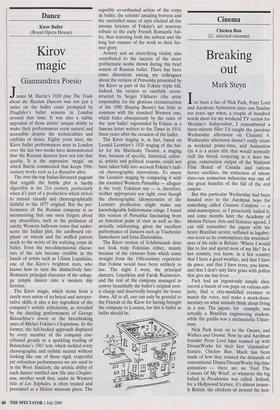Dance
Kirov Ballet (Royal Opera House)
Kirov magic
Giannandrea Poesio
James M. Barrie's 1920 play The Truth about the Russian Dancers was not just a satire on the ballet craze prompted by Diaghilev's ballet seasons in London around that time. It was also a subtle appraisal of those artists' unique ability to make their performances seem natural and accessible despite the technicalities and oddities of dance. Eighty years later, the Kirov ballet performances seen in London over the last two weeks have demonstrated that the Russian dancers have not lost that quality. It is the expressive 'magic' on which Barrie commented that keeps 19th- century works such as La Bayadere alive.
The over-the-top Indian-flavoured pageant that engulfs the feeble plot is hardly digestible in the 21st century, particularly when it's part of a production which strives to remain visually and choreographically faithful to the 1877 original. But the per- formance of the Russian company is so mesmerising that one soon forgets about any absurdities, such as the profusion of catchy Western ballroom tunes that under- score the Indian plot, the cardboard ele- phant on wheels and the stuffed parrots stuck to the wrists of the waltzing corps de ballet. Even the two-dimensional charac- ters of the tale become credible in the hands of artists such as Uliana Lopatkina, one of the Kirov's brightest stars, who knows how to turn the distinctively late- Romantic principal character of the unhap- py temple dancer into a modern day heroine.
The Kirov magic, which stems from a rarely seen union of technical and interpre- tative skills, is also a key ingredient of the company's artistic eclecticism, as revealed by the dazzling performances of George Balanchine's Jewels or the breathtaking ones of Michel Fokine's Chopiniana. In the former, the full-bodied approach displayed by every member of the company con- tributed greatly to a sparkling reading of Balanchine's 1967 text, which tackled every choreographic and stylistic nuance without looking like one of those rigid, respectful yet colourless performances we are used to in the West. Similarly, the artistic ability of each dancer instilled new life into Chopini- ana, another work that, under its Western title of Les Sylphides, is often treated and presented as a lifeless museum piece. The superbly co-ordinated action of the corps de ballet, the soloists' amazing bravura and the unrivalled sense of style elicited all the intense lyricism of Fokine's art nouveau tribute to the early French Romantic bal- let, thus restoring both the subtext and the long lost essence of the work to their for- mer glory.
Artistry and an electrifying vitality also contributed to the success of the more problematic works shown during this brief season of Russian ballet. There has been some discontent among my colleagues about the version of Petrushka presented by the Kirov as part of the Fokine triple bill. Indeed, the version so carefully recon- structed by Sergei Vikharev (the artist responsible for the glorious reconstruction of the 1890 Sleeping Beauty) has little in common with the standard Western one, which bides obsequiously by the rules of the `new ballet' expounded by Fokine in a famous letter written to the Times in 1914, three years after the creation of the ballet.
The Kirov staging is, in fact, based on Leonid Leontiev's 1920 staging of the bal- let for the Mariinsky Theatre, a staging that, because of specific, historical, cultur- al, artistic and political reasons, could not have taken fully into account Fokine's radi- cal choreographic innovations. To assess the Leontiev staging by comparing it with the standard Western Petrushka — alleged- ly the `truly' Fokinian one — is, therefore, neither appropriate nor right, even though the choreographic idiosyncrasies of the Leontiev production might make any knowledgeable balletomane cringe. I found this version of Petrushka fascinating from an historical point of view as well as the- atrically exhilarating, given the excellent performance of dancers such as Viacheslav Samodurov and Irina Zhelonkina.
The Kirov version of Scheherazade does not look truly Fokinian either, mainly because of the virtuoso feats which come straight from the 19th-century repertoire that Fokine would have been unlikely to use. The night I went, the principal dancers, Lopatkina and Faruk Ruzimatov, and the rest of the company managed to convey beautifully the ballet's original erot- ic charge and deservedly brought the house down. All in all, one can only be grateful to the Friends of the Kirov for having brought the company to London, for this is ballet as ballet should be.


























































 Previous page
Previous page